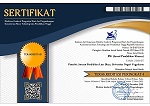The Dynamics of Special Interests Development in Autistic Student
Downloads
The purpose of this case study was to describe the dynamics of special interests development in an autistic student at Dian Amanah Special School Yogyakarta. This study collected data about: 1) form of special interests; 2) model of interest's development; 3) and consequence of special interests. Data were collected by observation, interview, and documentation technique. Data were analyzed data reduction, data display, and drawing conclusion/verification. The results showed 1) subject has 2 form of special interests on music and people; 2) special interests on music triggered by family and persisted by maintenance factor such as environmental opportunity, perception of ability, cognitive reward, and emotional reward while special interests on people triggered by other interests and persisted by maintenance factor such as environmental opportunity, cognitive reward, and emotional reward; 3) special interests on music viewed positively because there was perception of ability while SI on people viewed negatively due to behavioral problem.
Downloads
Anderson, L.W. & Krathwohl, D.R. (Eds.) (2001). A taxonomy for Learning, teaching, and assessing: A revision of Bloom's taxonomy of educational objectives. New York: Addison Wesley Longman.
APA. (2013). Diagnostic and Statistical Manual of Mental Disorders DSM-5. Washington DC: American Psychiatric Association.
Arikunto. (2010). Prosedur Penelitian: Suatu Pendekatan Praktek. Jakarta: Rineka Cipta.
Armstrong, K. (2014). Interests in Adults with Autism Spectrum Disorder. Simon Fraser University Library.
Caldwell-Harris, C. L., & Jordan, C. J. (2013). Systemizing and special interests: Characterizing the continuum from neurotypical to autism spectrum disorder. Elsevier, 98-105.
Grove, R., Hoekstra, R. A., Wierda, M., & Begeer, S. (2018). Special Interests and Subjective Wellbeing in Autistic Adults. Autism Research, 1.
Gunn, K. G., & Delafield-Butt, J. T. (2015). Teaching Children with Autism Spectrum Disorder with Restricted Interests: A Review of Evidence for Best Practice. Research Gate.
Mandy, R., & Dillo W. (2015). Course of Fascination: Special Interests in Asperger Autism. Austin Journal of Psychiatry and Behavioral Sciences, 2(3).
Nasution. (2009). Metode Research (Penelitian Ilmiah). Jakarta: Bumi Aksara
Renninger, K. A., & Wozniak, R. H. (1985). Effect of interest on attentional shift, recognition, and recall in young children. Developmental Psychology, 21(4), 624-632.
Sugiyono. (2009). Metode Penelitian Kuantitatif, Kualitatif dan R&D, Bandung: Alfabeta.
Sukmadinata, Nana Syaodih. (2009). Metode penelitian Pendidikan. Bandung: Remaja Rosdakarya
Winter-Messiers, M. A. (2007). From Tarantulas to Toilet Brushes: Understanding the Special Interest Areas of Children and Youth With Asperger Syndrome. Remedial and Special Education, 139-152.















